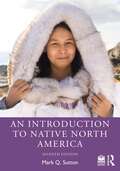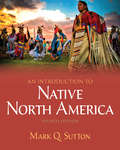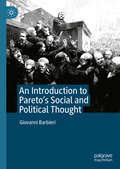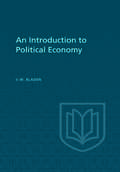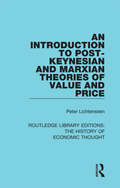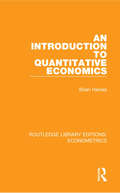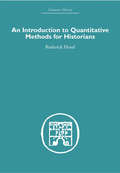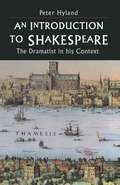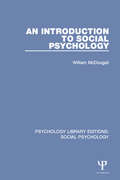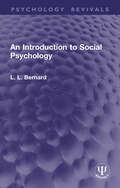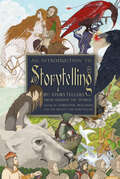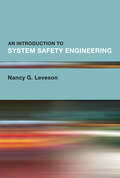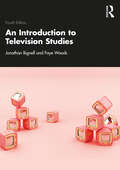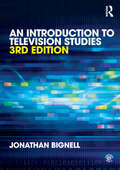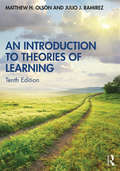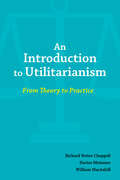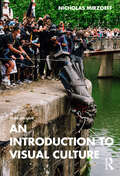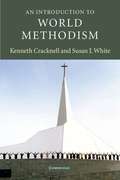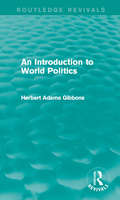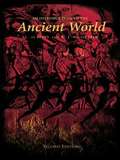- Table View
- List View
An Introduction to Native North America
by Mark Q. SuttonAn Introduction to Native North America provides a basic introduction to the Native peoples of North America, covering what are now the United States, northern Mexico, and Canada.In this updated and revised new edition, Mark Q. Sutton has expanded and improved the existing text, adding to the case studies, updating the text with the latest research, increasing the number of images, providing more coverage of the Arctic regions, and including new perspectives, particularly those of Native peoples. This book addresses the history of research, the European invasion, and the impact of Europeans on Native societies. A final chapter introduces contemporary Native Americans, discussing issues that affect them, including religion, health, and politics. The book retains a wealth of pedological features to aid and reinforce learning.Featuring case studies of many Native American groups, as well as some 87 maps and images, An Introduction to Native North America is an indispensable tool to those studying the history of North America and its Native peoples.
An Introduction to Native North America -- Pearson eText
by Mark Q. SuttonAn Introduction to Native North America provides a basic introduction to the native peoples of North America, including both the United States and Canada. It covers the history of research, basic prehistory, the European invasion and the impact of Europeans on Native cultures. Additionally, much of the book is written from the perspective of the ethnographic present, and the various cultures are described as they were at the specific times noted in the text. Teaching and Learning Experiences: Improve Critical Thinking - An Introduction to Native North America provides internet resources for students to supplement reading material, and contains an extensive bibliography to aid in their research. Engage Students - An Introduction to Native North America highlights important individuals in "VIP Profile" mini-biographies, and contains "Sidelights" throughout the text which provides short explanations of interesting aspects of native culture. Support Instructors - Teaching your course just got easier! You can create a Customized Text or use our Instructor's Manual, Electronic "MyTest" Test Bank or PowerPoint Presentation Slides. Plus, An Introduction to Native North America's organization was designed to be used in conjunction with the Handbook of North American Indians, published by the Smithsonian Institution.
An Introduction to Nineteenth-Century Art
by Michelle FacosUsing the tools of the "new" art history (feminism, Marxism, social context, etc.) An Introduction to Nineteenth-Century Art offers a richly textured, yet clear and logical, introduction to nineteenth-century art and culture. This textbook will provide readers with a basic historical framework of the period and the critical tools for interpreting and situating new and unfamiliar works of art. Michelle Facos goes beyond existing histories of nineteenth-century art, which often focus solely on France, Britain, and the United States, to incorporate artists and artworks from Scandinavia, Germany, and Eastern Europe. The book expertly balances its coverage of trends and individual artworks: where the salient trends are clear, trend-setting works are highlighted, and the complexity of the period is respected by situating all works in their proper social and historical context. In this way, the student reader achieves a more nuanced understanding of the way in which the story of nineteenth-century art is the story of the ways in which artists and society grappled with the problem of modernity. Key pedagogical features include: Data boxes provide statistics, timelines, charts, and historical information about the period to further situate artworks. Text boxes highlight extracts from original sources, citing the ideas of artists and their contemporaries, including historians, philosophers, critics, and theorists, to place artists and works in the broader context of aesthetic, cultural, intellectual, social, and political conditions in which artists were working. Beautifully illustrated with over 250 color images. Margin notes and glossary definitions. Online resources at www.routledge.com/textbooks/facos with access to a wealth of information, including original documents pertaining to artworks discussed in the textbook, contemporary criticism, timelines and maps to enrich your understanding of the period and allow for further comparison and exploration. Chapters take a thematic approach combined within an overarching chronology and more detailed discussions of individual works are always put in the context of the broader social picture, thus providing students with a sense of art history as a controversial and alive arena of study. Michelle Facos teaches art history at Indiana University, Bloomington. Her research explores the changing relationship between artists and society since the Enlightenment and issues of identity. Prior publications include Nationalism and the Nordic Imagination: Swedish Painting of the 1890s (1998), Art, Culture and National Identity in Fin-de-Siècle Europe, co-edited with Sharon Hirsh (2003), and Symbolist Art in Context (2009).
An Introduction to Pareto's Social and Political Thought
by Giovanni BarbieriThis book analyses Pareto&’s social and political thought a hundred years after his death, showing how the structure of the scholar&’s works is generally quite clear (contrary to what is commonly presumed), and how the maintenance of the social and political systems&’ equilibrium represents Pareto&’s main research focus . In particular, the aim of this book is to demonstrate how the author considers the &‘right middle path&’ – in the social, economic, and political arenas – as the only way capable of ensuring social cohesion. The book will be of interest to scholars and researchers of sociology, sociological and political theory, and political science.
An Introduction to Philosophy: A Christian Guide to the Things that Really Matter
by Steven B. Sherman Richard A. Holland Gary S. Osmundsen Peter J. RasorDesigned for students in Christian colleges and seminaries, An Introduction to Philosophy surveys the four main areas of philosophy - logic, metaphysics, epistemology, and ethics - in an accessible and engaging manner. Yet it also covers important topics sometimes left unaddressed in introductions, including:why philosophy matters in our daycritical thinking and intellectual virtuea brief history of philosophyphilosophical hermeneuticsthe relationship between philosophy, faith, and worldviewreligious epistemologybioethics, sexual ethics, other types of ethicsa Christian philosophy of lifeGrounded in the Christian intellectual tradition, each chapter in An Introduction to Philosophy includes student-friendly features such as chapter summaries, explanatory sidebars, reflection questions, vocabulary words and definitions, and suggestions for further reading. Professors and students will find it to be a broad and useful overview, perfect for undergraduate and seminary students alike.
An Introduction to Political Economy
by Vincent BladenNewly revised by the author (1956), this text-book for beginning students is also designed for general readers who want to know what economics is and how economists think. It analyses the size and composition of the wage-earner in modern industry, Canadian public policy in relation to combines, and the the social problems of the special problems of the Canadian wheat-growing and newsprint industries. "...an interesting, instructive, and valuable book full of essential information."
An Introduction to Political Philosophy (Routledge Revivals)
by A. R. MurrayFirst published in 1953, this seminal introduction to political philosophy is intended for both the student of political theory and for the general reader. After an introduction which explains the nature and purpose of philosophy, Dr Murray provides a critical examination of the principle theories advanced by political philosophers from Plato to Marx, paying special attention to contemporary issues. The book also makes an attempt to define the essential issues of philosophical significance in contemporary politics, with special reference to the conflict between political authority and individual rights, and to show how the different moral assumptions underlying authoritarian and democratic systems of government are ultimately based upon different theories of logic.
An Introduction to Post-Keynesian and Marxian Theories of Value and Price (Routledge Library Editions: The History of Economic Thought)
by Peter M. LichtensteinPeter M. Lichtenstein believes that any social-economic theory of capitalism must begin with a theory of value and price. Dismissing the neoclassical school, he turns to post-Keynesian and Marxian economics with their coherent and consistent theories of value and price based on concrete objective circumstances. The development of these theories in the author’s aim because he believes that this approach comes much closer than neoclassical theory to capturing the essence of a capitalism economy. This book, first published in 1983, is addressed to economics students, especially to those studying microeconomics or the history of economic thought, and to economists seeking an overview of these issues.
An Introduction to Quantitative Economics (Routledge Library Editions: Econometrics #8)
by Brian HainesOriginally published in 1978. This book is designed to enable students on main courses in economics to comprehend literature which employs econometric techniques as a method of analysis, to use econometric techniques themselves to test hypotheses about economic relationships and to understand some of the difficulties involved in interpreting results. While the book is mainly aimed at second-year undergraduates undertaking courses in applied economics, its scope is sufficiently wide to take in students at postgraduate level who have no background in econometrics - it integrates fully the mathematical and statistical techniques used in econometrics with micro- and macroeconomic case studies.
An Introduction to Quantitative Methods for Historians (Economic History Ser.)
by Roderick FloudMany statements made by historians are quantitative statements, involving the use of measurable historical evidence. The historian who uses quantitative methods to analyse and interpret such information needs to be well acquainted with the particular methods and techniques of analysis and to be able to make the best use of the data that are available. There is an increasing need for training in such methods and in the interpretation of the large volume of literature now using quantitative techniques. Dr Floud’s text, which is relevant to all branches of historical inquiry, provides a straightforward and intelligible introduction for all students and research workers. The simpler and more useful techniques of descriptive and analytical statistics are described, up to the level of simple linear regression. Historical examples are used throughout, and great attention is paid to the need to ensure that the techniques are consistent with the quality of the data and with the historical problems they are intended to solve. Attention is paid to problems of the analysis of time series, which are of particular use to historians. No previous knowledge of statistics is assumed, and the simple mathematical techniques that are used are fully and clearly explained, without the use of more mathematical knowledge than is provided by an O-level course. A bibliography is provided to guide historians towards the most useful further reading. This student friendly text was first published in 1973.
An Introduction to Shakespeare
by Peter HylandPeter Hyland provides a highly readable account of the historical, social and political pressures of Shakespeare's England and the material conditions under which his plays were written, including a comprehensive description of the development and status of the theatrical profession. Half of the book is given over to a survey of the plays and examines numerous controversial issues that arise when we ask precisely what we can 'know' about them. For those who are daunted by the volume or the impenetrable prose of much recent writing on Shakespeare, Hyland's book will be a stimulating introduction.
An Introduction to Social Psychology (Psychology Library Editions: Social Psychology)
by William McDougallOn its first publication in 1908 this pioneer book received immediate acclaim and was thought to have probably done more than any other single publication to stimulate study of the foundations of social behaviour. Professor McDougall was the most powerful advocate of an idealistic outlook on human life and activity, and his ideas continued to attract attention even when published in paperback form in 1960.
An Introduction to Social Psychology (Psychology Revivals)
by L. L. BernardOriginally published in 1927, An Introduction to Social Psychology represents an attempt at a more synthetic type of treatment of the field than had previously been given. The author felt that the time had arrived when “schools” of social psychology may properly be regarded as obsolete and the subject as a whole may be presented systematically. At the time social psychology was emerging as a separate discipline and overlapped a very large portion of social science, psychology and education. In this respect it was central to all psychological and social science disciplines. This volume treats the subject from the standpoint of the more objective factors which integrate the personality and its responses in a social environment. Today it can be read in its historical context.This book is a re-issue originally published in 1927. The language used and views portrayed are a reflection of its era and no offence is meant by the Publishers to any reader by this re-publication.
An Introduction to South Asia (Routledge Revivals)
by B.H. FarmerOriginally published in 1983 and here reissuing the second edition of 1993, An Introduction to South Asia presents the geographical and historical background to the diversities of the region. From the legacy of the colonial period and the controversies that surrounded partition and independence, the book traces the consequences of social divisions, particularly of religion, caste and language, into contemporary politics. Interwoven issues on environments, sociology, politics, and economies combine to explain development patterns and problems, the processes behind them, and the reciprocal impact of South Asia and the wider world.This fully updated second edition provides new material on environmental issues, the causes and consequences of natural disasters, and the role of women in the region. It provides a comprehensive, interdisciplinary guide to the varying environments—natural, social, political, and economic—that characterize South Asia.
An Introduction to Storytelling: By Storytellers from Around the World
by Christine WillisonWhere do stories come from, and how do we come to know them? Daughters listen with wonder to their grandmothers’ tales. Journalists have their trusted sources. Writers of storybooks draw unconsciously from the works of their predecessors. It is as if every story has within it an infallible truth, contained in the echo of its original telling. The storyteller recounts the tale. The listener hears, learns and remembers. In due course they will retell the same tale, adding in something of their own. And so listeners in time turn into storytellers. This inspiring book brings together the stories from across the world of listeners who themselves became storytellers. They reveal who influenced them the most, what drew them further in, what they learnt, and what they now wish to share with new generations. Tips, tools and tales: read this book, and take your turn.
An Introduction to System Safety Engineering
by Nancy G. LevesonA comprehensive, up-to-date introduction to the foundations of classical safety engineering, with an emphasis on preparing for future challenges.Systems today are orders of magnitude more complex than in the past, and their complexity is increasing exponentially. Preventing accidents and losses in such systems requires a holistic perspective that can accommodate unprecedented types of technology and design. This textbook teaches the foundations of classical safety engineering while incorporating the principles of systems thinking and systems theory. Beginning with the framing and lessons of her classic text, Safeware, Nancy Leveson builds on established knowledge and brings the field up to date, challenging old approaches and introducing new ones. This essential book provides the core information required to build safety-critical systems today and in the future, including coverage of the historical and legal frameworks in which the field operates as well as discussions of risk, ethics, and policy implications. Presents cutting-edge concepts anticipating the safety challenges of the future alongside thorough treatment of historical practices and ideasProvides a comprehensive introduction to the foundations of safety engineeringCovers accident analysis, hazard analysis, design for safety, human factors, management, and operationsIncorporates extensive examples of real-world accidents and applications Ideal for students new to safety engineering as well as professionals looking to keep pace with a rapidly changing field
An Introduction to Television Studies
by Jonathan Bignell Faye WoodsThis comprehensive textbook, now substantially updated for its fourth edition, provides students with a framework for understanding the key concepts and main approaches to Television Studies, including audiences, representation, industry and global television, as well as the analytical study of individual programmes. This new edition reflects the significant changes the television industry is undergoing in the streaming era with an explosion of new content and providers, whilst also identifying how many existing practices have endured. The book includes a glossary of key terms, with each chapter suggesting further reading. New and updated material includes: Chapters on style and form, narrative, industry, and representation and identity Case studies on Bon Appétit’s YouTube channel, Insecure, British youth television, ABC and Disney+, fixed-rig observational documentary, streaming platforms' use of data to shape audience experience, Chewing Gum, Korean drama and The Marvelous Mrs Maisel Sections on medical drama, YouTube creators, Skam and scripted format sales, the global spread of streaming platforms, prestige TV and period drama With individual chapters addressing television style and form, narrative, histories, industries, genres and formats, realities, production, audiences, representation and identity, and quality, this book is essential reading for both students and scholars of Television Studies.
An Introduction to Television Studies
by Jonathan BignellIn this comprehensive textbook, now updated for its third edition, Jonathan Bignell provides students with a framework for understanding the key concepts and main approaches to Television Studies, including audience research, television history and broadcasting policy, and the analytical study of individual programmes. Features include: a glossary of key terms key terms defined in margins suggestions for further reading activities/assignments for use in class New and updated case studies feature: ‘Every Home Needs a Harvey’ ad approaches to news reporting television scheduling CSI Crime Scene Investigation animated cartoon series Individual chapters address: studying television, television histories, television cultures, television texts and narratives, television genres and formats, television production, television and quality, television realities, television you can’t see, television audiences, beyond television.
An Introduction to Theories of Learning
by Matthew H. Olson Julio J. RamirezSince its first edition, An Introduction to Theories of Learning has provided a uniquely sweeping review of the major learning theories from the 20th century that profoundly influenced the field of psychology. In this tenth edition, the authors present further experimental evidence that tests many of the fundamental ideas presented in these classic theories, as well as explore many of the advances in psychological science and neuroscience that have yielded greater insight into the processes that underlie learning in human beings and animals. The four main goals of this text are to define learning and to show how the learning process is studied (Chapters 1 and 2), to place learning theory in historical perspective (Chapter 3), and to present essential features of the major theories of learning with implications for educational practices (Chapters 4 through 16). The authors retained the best features of earlier editions while making revisions that reflect current research and scholarship, including coverage of active learning and the testing effect, information for problem solving in ravens, data illustrating the neurobiological basis of the cognitive map and spatial learning, new research on brain plasticity and its role in learning as well as the impact of poverty on brain and cognitive development, and new evidence that challenges the notion of learning styles. Complete with chapter summaries, discussion questions, glossary, and online resources for instructors, this text is essential reading for theories of learning and applied cognitive psychology courses.
An Introduction to Third World Theologies
by John ParrattProviding the first overview of the main trends and contributions to Christian thought of Third World theologies, this book gathers essays from experts on Latin America, India, East Asia, West and East Africa, Southern Africa and the Caribbean. It analyzes the common context of the Third World theologies in their experience of colonialism and Western missions, and suggests that they provide different perspectives on what it means to be a Christian in today's world.
An Introduction to Utilitarianism: From Theory to Practice
by William MacAskill Prof. Richard Chappell Mr. Darius MeissnerAn Introduction to Utilitarianism: From Theory to Practice is a state-of-the-art text, simultaneously accessible to introductory students and informative for more advanced readers. Two key features set it apart. First, its comprehensive coverage of the arguments for and against utilitarianism is unparalleled. Second, it takes seriously the practical implications of utilitarianism for how we should live, with a particular emphasis on utilitarianism's impartial beneficence and its focus on effectiveness. Guided by the conviction that practical ethics is more about how best to use our limited time and resources than which victims to hit with trolleys in thought experiments, its practical upshots should prove amenable to utilitarians and non-utilitarians alike.
An Introduction to Visual Culture
by Nicholas MirzoeffIn the fully rewritten third edition of this classic text, Nicholas Mirzoeff introduces visual culture as visual activism, or activating the visible. In this view, visual culture is a practice: a way of doing, making, and seeing. The 12 new chapters begin with five foundational concepts, including Indigenous ways of seeing, visual activism in the wake of slavery, and unfixing the gaze. The second section outlines three currently successful tactics of visual activism: removal of statues and monuments; restitution of cultural property; and practices of repair and reparations. The final section addresses catastrophe and trauma, from Palestine’s Nakba to the climate disaster and the intersections of plague and war. Each section also includes new, in-depth case studies called "Visualizations," ranging from oil painting to Kongo power figures and the mediated practice of taking a knee. Engaging with questions of racializing, colonialism, and undoing gender throughout, this edition maps the activist turn in the field since 2014 and sets directions for its future expansion. This is a key text in visual culture studies and an essential resource for research and teaching in the field.
An Introduction to World Methodism
by Kenneth Cracknell Susan J. WhiteWith over 75 million currently practicing Methodists worldwide, this book treats Methodism as a global religious tradition, examining its rich diversity as well as the core beliefs and attitudes that all Methodists share. It serves as an introduction to the patterns of Methodist life, demonstrating how the religion has developed from British and American roots in different cultural contexts. In addition to the lasting traditions of John and Charles Wesley, An Introduction to Methodism reflects the on-going contribution of Methodism to the ecumenical movement and inter-religious relations. Its analysis includes abundant resources encouraging further study. Kenneth Cracknell is Professor of Theology and Global Studies at Brite Divinity School, Fort Worth, Texas. He has been a theological teacher in Nigeria, a Methodist pastor in Britain, and Director of Interfaith Relations for the British Council of Churches. He has also been a consultant to the World Council of Churches on interfaith issues since 1979 and has visited churches in all parts of the world. He is the author of Toward a New Relationship: Christians and People of Other Faith (Epworth Press, 1986) and Justice, Courtesy and Love: Theologians and Missionaries Encountering Other Religions 1846-1914 (Epworth, 1995). Susan J. White is Alberta H. and Harold L. Lunger Professor of Spiritual Resources and Disciplines at Brite Divinity School, Fort Worth, Texas. She has been a member of the Church of England Liturgical Commission, and the Joint Liturgical Group of Great Britain and Ireland, and consultant for liturgical revision to the Methodist Faith and Order Committee and the Office of Worship of the Board of Discipleship of the United Methodist Church. She is the author of Groundwork of Christian Worship (Epworth, 1997) The Spirit of Worship: The Liturgical Tradition (Orbis Books, 2000) and A History of Women in Christian Worship (Pilgrim Press, 2003)
An Introduction to World Politics (Routledge Revivals)
by Herbert Adams GibbonsOriginally published in 1922, An Introduction to World Politics, was published at a particularly interesting time in international relations, just a few short years after the first world war. With this in mind, Gibbons has approached this text as a general introduction to world politics, both examining causes of recent events in his lifetime as well as exploring what he refers to as ‘the beginning’ of World Politics. This study delves into various aspects of world politics throughout history including the colonialism of the British and the French and several wars and treaties with analysis on how this impacted on relations between nations. This title will be of interest to students of Political History and International Relations.
An Introduction to the Ancient World
by Lukas De Blois R.J. van der Spek L De Blois R. J. van der SpekIntegrating the results of scholarly work from the past decade, the authors of An Introduction to the Ancient World, Lukas de Blois and R.J. van der Spek, have fully-updated and revised all sixteen chapters of this best-selling introductory textbook. Covering the history and culture of the ancient Near East, Greece and Rome within the framework of a short narrative history of events, this book offers an easily readable, integrated overview for students of history, classics, archaeology and philosophy, whether at college, at undergraduate level or among the wider reading public. This revised second edition offers a new section on early Christianity and more specific information on the religions, economies, and societies of the ancient Near East. There is extended coverage of Greek, Macedonian and Near Eastern history of the fourth to second centuries BC and the history of the Late Roman Republic. The consequences of Julius Caesar's violent death are covered in more detail, as are the history and society of Imperial Rome. This new edition is: comprehensive: covers 3,000 years of ancient history and provides the basis for a typical one-semester course lavishly illustrated: contains maps, line drawings and plates to support and supplement the text, with updated captions clearly and concisely written: two established and respected university teachers with thirty years' experience in the subject areas well-organized: traces the broad outline of political history but also concentrates on particular topics user-friendly: includes chapter menus, an extensive and expanded bibliography organized by subject area and three appendices, an improved introduction and the addition of an epilogue.
